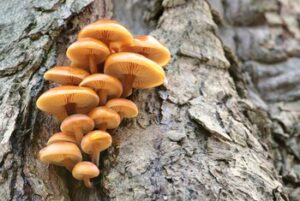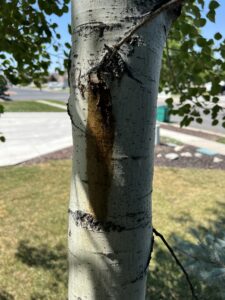
One of our most frequent calls is from people who are trying to decide if their tree can be saved or if they need to bite the bullet and get it removed. When we inspect trees, we generally look for the following to see if they are really dead or can be saved:
- bark falling off around base of tree
- mushrooms or fungus growing on the tree, especially near the base or on roots of the tree
- dead wood and dieback of the branches, especially at the crown of the tree
- abnormal coloring on the tree foliage
- multiple small pinholes in the tree
- discoloration on the bark like something dark is staining the tree and dripping from it
- big gashes or broken limbs
Bark falling off of the tree is usually a sign that the tree is dying from the inside out. Once the bark is detached and starts falling off, it is a pretty good indicator that the tree is diseased and is dying from the inside out. In many cases we notice that if you were to cut the trunk in half, you would see that half of the tree is living and half of it is dead wood.
Mushrooms or fungus growth indicates that there are portions of the tree that are dead and are being digested by parasitic mushrooms or fungus. This rarely happens until a tree is so far gone that it cannot be saved.

Dead wood can often mean that a tree has a disease or a bug and is slowly dying. Catching a tree early that has dieback and treating it with a systemic product such as Tree Age, can kill the disease or bug and save your tree.
Abnormal coloring of the foliage often indicates iron chlorosis–a condition in which a tree is not receiving adequate iron and other minerals from the soil. This is common in silver maples that are used to acidic soil and do not thrive in the alkaline soil commonly found in residential areas in Utah. The tree pictured below is in the early stages of iron chlorosis. As the tree gets more and more chlorotic (meaning lacking in iron and other essential minerals), the tree will get more and more yellow. Eventually leaves will “burn” meaning that they turn brown or black or curl at the edges. In the later stages, entire sections of the tree will turn brown and die.

Multiple small pinholes can indicate that a borer or other bug has infested the tree and needs to be treated with a systemic product. Look closely and you’ll notice multiple small holes in this tree from borer insects.

Discoloration indicates that the tree is seeping out sap or other “tree blood” and that probably has a borer or other bug infesting it. The pic below is of a quacking aspen tree that has a fungus that causes seeping and dark discoloration.

Finally, it is important to note that big gashes or broken limbs can permanently weaken a tree’s health and cause the tree to die. This flowering pear tree below suffered wind damage and will never fully recover. Instead, the open gash will lead to infestation and the tree will eventually die.
.
